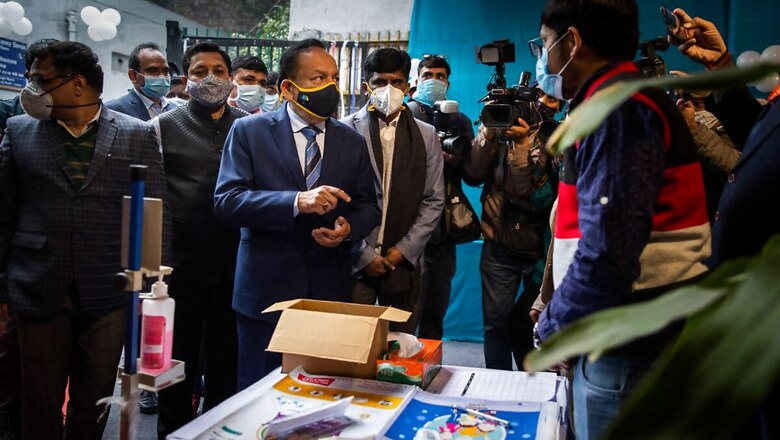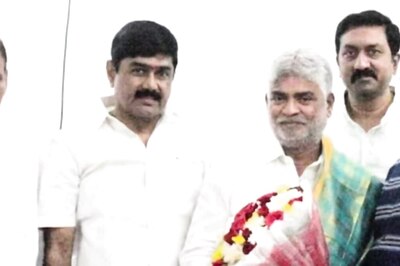
views
Last week, during a dry run drill for the Covid-19 vaccination programme, authorities in Chhattisgarh’s health department came across a peculiar problem. The Co-Win application, which will be the backbone for the mega vaccination drive, didn’t accept registrations for Gaurela-Pendra-Marwahi district. The newly formed district in Chhattisgarh, carved out of Bilaspur in February 2020, does not have a pincode and this brought to the fore the issue on the app, said TS Singh Deo, the state’s health minister.
“When we started working on the CoWin App, it did not accept registrations because that district has not yet been given a pincode. This may not have been in our minds when we were planning. These sorts of things come up during a dry run,” Deo told News18.
This peculiar issue from Chhattisgarh is indicative of the challenges, small and big, that states will face as India begins its vaccination drive against Covid-19 from January 17. This will be India’s first vaccination drive involving adults as the existing universal immunization programme only covers children and pregnant women.
The first phase of the vaccination will cover 30 crore Indians – three crore healthcare workers and frontline workers and about 27 crore people who are above the age of 50 years and person below 50 years with associated comorbidities.
As part of the preparations for the inoculation drive against Coronavirus, state governments were asked to register a comprehensive list of healthcare workers, frontline workers, those above the age of 50-55 and those below 50 years of age with pre-existing comorbidities.
Dry runs and vaccination capacities
Between 2-8 January, all districts of the country went through a dry run for testing vaccination preparedness at least once. These dry runs involved mock vaccination, testing of the Co-Win platform for registrations of beneficiaries and data uploading, microplanning and checking for preparedness of the session sites, where the actual vaccination will take place.
Officials said that two-three key issues came to the fore during the dry runs. These included ensuring beneficiaries are made to wait for 30 minutes following vaccination to monitor them for side effects and identifying the right capacity for vaccinations per day.
During the whole vaccination process, the third and fourth vaccination officer will have to be alert to ensure that a beneficiary has waited for 30 minutes post vaccination, said Hussan Lal, Principal Secretary, Health Department, Punjab. “These officers should maintain a log chart to record the entry and exit of the beneficiary, this would confirm that they have waited for 30 minutes.”
It is imperative for a beneficiary to wait for 30 minutes in the observation room to tackle any side effects or adverse effects that may occur following vaccination.
“We have to be careful that nobody walks off after vaccination and that people wait for 30 minutes,” said TS Singh Deo, echoing the views of Hussan Lal.
A few state officials told News18 that about 5-7 people can be administered the vaccine in 30 minutes and that it was important to balance the number of vaccinations based on the available human resources.
Punjab health secretary Hussan Lal said that an estimated four lakh people could be vaccinated in a day if all 4,000 vaccinators are available. “We have that capacity. So, we can vaccinate all our 1.57 lakh healthcare workers in one day. However, we would like to see how many doses we would get and we will go a bit slow initially to ensure a smooth rollout,” Lal said.
Punjab gas 729 cold chain points, 4,000 vaccinators and 11,000 session sites or locations such as schools or government buildings where the actual vaccination would happen.
During the dry run, states have also identified issues such as provisioning of emergency ambulances in remote areas as an important requisite for the actual vaccination period.
Identifying beneficiaries
Top officials from a few key states with a high number of cases told News18 that while details of healthcare workers have been uploaded on Co-Win digital platform, data was being compiled on other frontline workers such as police, paramilitary and revenue officials. States are also yet to fully compile data of those above 50 years of age and of those with comorbidities.
Officials said that voter lists and the Aadhaar database will come in handy for compiling these lists. West Bengal health secretary Narayan Swaroop Nigam said that the state has already compiled data on comorbidities among the state population based on a survey and information from hospitals.
Chhattisgarh has identified 2.54 lakh healthcare workers; Karnataka has identified 6.4 healthcare workers which includes ASHA (Accredited social health activist) workers; Punjab has identified 1.57 lakh healthcare workers and West Bengal has identified 6 lakh healthcare workers, top officials from state health department told News18.
Meanwhile, Haryana has estimated that about 67 lakh people will be vaccinated in an year. This would include 1.89 healthcare workers, about 4.5 lakh frontline workers, 58 lakh people above the age of 50 and about 2.25 lakh people below 50 years of age with comorbidities.
Read all the Latest News, Breaking News and Coronavirus News here


















Comments
0 comment